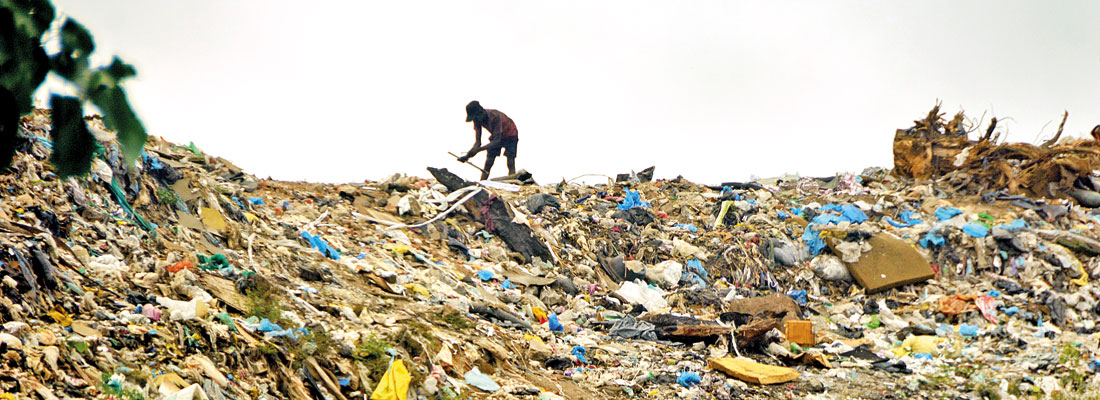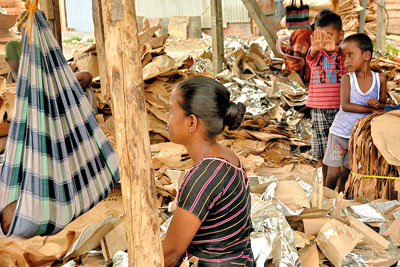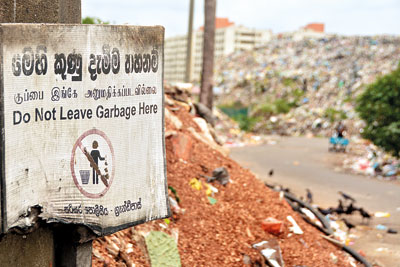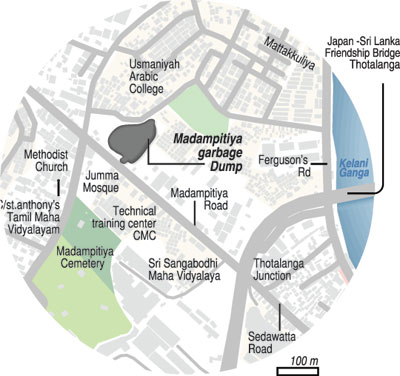News
Colombo municipality dumps waste creating public health risk
View(s):
Residents fear that the garbage dump will collapse. Pix by M.D. Nissanka
By Renishka Fernando
Residents are not pleased.
“By 6 p.m., there are so many mosquitoes, we can’t stay inside, or outside the house,” said Nazeeth, 62, who prefers to go by his first name.
He has lived in Madampitiya for 24 years. While it was initially a residential area, the houses had been demolished and the land had been claimed by the Urban Development Authority (UDA), which had provided the residents with houses from six housing schemes: Sathhiru Sevana, Helamuthu Sevana, Mihijaya Sevana, Ranmithu Sevana, Methsanda Sevana, and Randiya Uyana.
However, there are a few shacks housing people who have not received houses from the scheme and a few more shacks store segregated garbage which some residents sell to earn a living.
The build-up of this dump site, which is a few metres away from Mr Nazeeth’s house, comes just after Bloemendhal dump site was partially cleared up by authorities. The odour, rats, flies and mosquitoes are only a part of the health hazards.

The smell is unbearable not to mention the health hazzards, say residents
“This is a nuisance to the public.”
The smell is unbearable, the residents said.
The dump continues to rise higher. According to Mr Nazeeth, the garbage is levelled and flattened to make space for more waste.
“Even though there are health hazards, we earn a living from this dump. We eat from the money we get from segregating garbage,” said Ms Nirosha, who only wished to share her first name.
The 21-year-old is a mother of two aged six months, and six years. Her father has been collecting garbage since she was a little girl. He climbs the dump site every day and separates glass and polythene waste and then sells it to shops for a living.
Although Ms Nirosha and her family are used to this way of life, she is worried for her children.
On rainy days, her children have to wade through muck. The odour is unbearable.
Although there are fears that the garbage dump will collapse, residents have not complained to the CMC, the Central Environmental Authority (CEA), or the police.
They believe that their pleas will go unheard like those of the residents of Meethotamulla where the massive dump collapsed causing deaths.
Both Mr Nazeeth and Ms Nirosha said that even if they do complain, measures will not be taken by local authorities.
Ms Shahina Mysan, the director of solid waste management at the CMC, said: “We are looking at several options because some of the waste cannot be sent to the waste to energy plant in Kerawalapitiya.’’ The mayor and commissioner had been informed and plans are underway to find another suitable site.
Methods to separate soil and polythene are being considered so that soil can be re-used for agriculture and the latter can be sent to Kerawalapitiya.
CMC officials declined further comment regarding the height and area of the dump site and about for how long Madampitiya had been used to dump waste.
Ms Mysan told the Sunday Times that an Environmental Impact Assessment (EIA) had not been done in Madampitiya.
She admits there are public health risks.

The notice is of no avail as the dump grows higher and higher by the day
“If we don’t dump the non-degradable waste there, the streets of Colombo will be piled up with garbage and the city will be polluted.’’
“We don’t do EIAs for garbage dumping. We only do them for approved projects like the Kerawalapitiya waste to energy plant,” said Mr Upali Indrarathne, the deputy director general of waste management.
During rains, the chemicals, plastic and polythene in the dump site flow into drains polluting nearby water bodies with heavy metals and other hazardous waste. The soil is polluted.
“The CMC is committing three offences by dumping garbage. The first is illegal dumping and soil and water pollution, are the second and third,” said Dr Ravindranath Dabare, the chairman of the Centre for Environmental Justice.
He said damages can be claimed under the polluter pays principle.
There are several legal remedies which people can resort to.
Under section 98 of the Criminal Procedure Code when any project/ activity causes or there is an imminent threat of causing a health hazard for any affected party, any person on behalf of the aggrieved party can go to the Magistrate’s Court and get a conditional order against the CMC.
An aggrieved party can also go to the District Court and get an injunction against the CMC, or a private party.
Also, under the writ jurisdiction of the Court of Appeal, a writ of mandamus can be sought against the CEA and the CMC. The writ of mandamus is an order compelling the Government authority to perform its duties. The police, too, can take action where there is soil and water pollution involved.
“The lack of knowledge of the legal measures available and environmental conservation is a serious issue,’’ said Dr Dabare.
“We should have a comprehensive plan to deal with garbage accumulation,” said Dr Jagath Gunawardana, who has been in the environmental conservation field for 44 years. According to him, the first step in garbage disposal is segregation before methodical disposal.
Individuals who separate garbage should be given protective gear and sanitary facilities.
The irresponsibility and carelessness of officials in charge of waste management are significant issues. 
Dr Gunawardana said that the garbage issue has to be solved by local authorities – municipal and urban councils, and pradeshiya sabhas.
He noted that officials elected to these bodies are not aware of their duties and responsibilities.
“We need to elect the right officials, until then the blame will be passed from one authority to the other. The duties of the CEA are hampered by political intervention,” Dr Gunawardana said.
Under section 12 of the National Environment Act, the minister has to approve the course of action that the CEA will take by issuing a directive against the local government authority that is not complying with its duties and responsibilities.
The best way to say that you found the home of your dreams is by finding it on Hitad.lk. We have listings for apartments for sale or rent in Sri Lanka, no matter what locale you're looking for! Whether you live in Colombo, Galle, Kandy, Matara, Jaffna and more - we've got them all!

